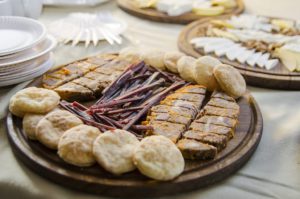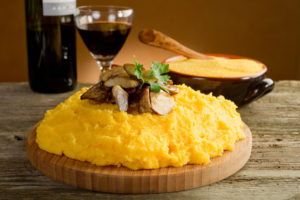
Cuisine of the Lower Danube region and its ethnographic composition is very colorful. Here live and Bulgarians, and Gagauzes, and Jews, and, of course, Ukrainians. All traditions and all cultures are reflected on Bessarabian cuisine in whole.
Common among such a variety of dishes of different nations is the use of vegetables, herbs, spices, fruits.
Moldavian and Romanian Cuisines
Moldavian cuisine cannot be imagined without a traditional Mămăligă (corn porridge or bread) which is prepared in a cast-iron pot with thick walls and bottom. It is laid out on a wooden board and cut by thread. Most often, mămăligă is flavored with cheese, sour cream, milk, eggs, onions, cracklings. Also traditional dishes are plăcintă (a piece of puff pastry with various fillings: brynza, cabbage, potatoes, mushrooms, eggs, cheese, meat, pumpkin),  sarmale (meat, corn or rice, bell pepper, carrots, onion, wrapped in pickled grape leaves or cabbage sour leaves).
sarmale (meat, corn or rice, bell pepper, carrots, onion, wrapped in pickled grape leaves or cabbage sour leaves).
Vegetables play a huge role in the Moldavian cuisine. They are often boiled, baked, stuffed, stewed and salted, rarely – roasted them. The most popular are cereal and string beans, lentils, tomatoes, gogoshars (tomato sweet peppers), sweet peppers, eggplant, zucchini. Beans are often used in the form of mashed potatoes – beaten with onions and oils. Peppers, eggplants, goshashars are usually stuffed with other vegetables or rice with vegetables and meat. Very often vegetables are consumed with sauces, marinades and dressings, made from wine, sour cream, spicy vegetables and herbs.
Meat occupies a special place in Moldavian and Romanian cuisines. In addition to lamb, they use veal, pork, beef, and poultry. It is cooked necessarily in combination with vegetables and fruits.The visiting card of the Moldavian cuisine is ciorbă, zeamă sirbush. Especially tasty among meat dishes are mititie – veal sausages without shell and kavarma that is prepared from mutton meat.
Another special product of Moldavian cuisine is brynza. Brynza is accepted not only as a daily snack, but also as an additive and stuffing for vegetable, egg, flour and meat dishes.
Bolgarian Cuisine
 In Bulgarian cuisine, salads are mainly with vegetables, and fresh and pickled vegetables and herbs are used. As for the Bulgarian cuisine, the bases of many of its dishes are cheeses, these are brynza (sirens) and yellow fermented cheese (Kashkaval). Cheese is an ingredient in many salads and casseroles. Sauces are also from vegetables, for example, Lutenitsa. As bread Bulgarians use pita, and sweet cakes – kozunaki.
In Bulgarian cuisine, salads are mainly with vegetables, and fresh and pickled vegetables and herbs are used. As for the Bulgarian cuisine, the bases of many of its dishes are cheeses, these are brynza (sirens) and yellow fermented cheese (Kashkaval). Cheese is an ingredient in many salads and casseroles. Sauces are also from vegetables, for example, Lutenitsa. As bread Bulgarians use pita, and sweet cakes – kozunaki.
Bulgarian cuisine is rich in soups: green, meat and fish, which are prepared depending on the season. For example, a tarator usually prepares in the summer. Also, one of the most famous Bulgarian soups is “Shkembe Chorba” and “Kurban Chorba”.
Particular attention deserves to a Bulgarian pie of puff pastry with brynza or cheese – millina.
The cuisine of the Danube region is very colorful, here you can try the Jewish forshmak from fish, oil, apples and onions, Lipovans’ royal fish soup with Danube herring or several types of fish with garlic Salamur. One thing remains unchanged, the Danube cuisine is a limitless world of tastes that can satisfy any gastronomic critic. In the future, we take a closer look at other gastronomic secrets of the Bessarabian cuisine.
